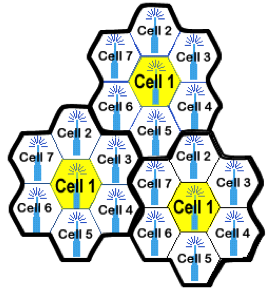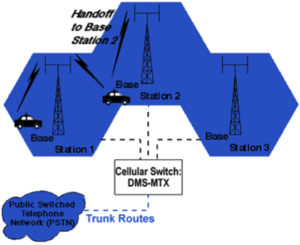
The cells are connected to several back-end systems that handle traffic, connect mobile devices together, and manage handoff of mobile devices from one cell to another (see figure). Communication between mobile devices and cells occurs through radio channels between the cell and the mobile device—one channel for mobile to cell communications and one for cell to mobile communications, enabling simultaneous two-way data transmission (Rappaport et al., 2000). Additional channels are used as control channels, to handle call requests, registering mobile devices with cells, etc.
When a user initiates a network connection event (e.g. a voice-call), the cellular network operator needs to know his/her location in order to determine the cell tower used to channel this event (Chen, 2016). Thus, the positioning data (containing information on users’ locations) is generated when an event occurs. Such data is automatically and passively generated for cellular network operators’ own purposes, including billing information collection and network management. Device movements are tracked based on analysis of mobile device sightings and activity locations over a set time period, ranging from weeks to months.
Airsage, GA-based wireless information provider, is the only supplier of cellular location data. Airsage has agreements with one or more nationwide cellular device carriers, which allows it to access wireless signaling data with the legal stipulation that the raw, unprocessed data be protected and not shared. So Airsage data must ensure the anonymity of the data through its aggregation. All records are encrypted to anonymize specific individuals or mobile devices. Active pinging of cell devices or tablets is another source but it can only be used with a group of study participants who have agreed to allow themselves to be pinged in order to identify their location. Unlike GPS data, privacy protections are built into the access provisions of cellular data. Cellular data can only be procured at the aggregated level, while disaggregated GPS data can be procured.
Agencies and organizations typically only need an acquisition/subscription agreement with a data aggregator and vendor to obtain the data. but they may need GIS, and databasing capabilities to analyze and visualize the data. Policy or planning decision making based on cellular data may have equity concerns. The percent of the population that is represented in Airsage’s data is dependent upon the penetration rates of the carriers with whom Airsage has agreements. Percents can vary across geographics with greater penetrations in urban areas and less penetrations in rural areas, especially rural areas with only one provider (Hard et al, 2016).